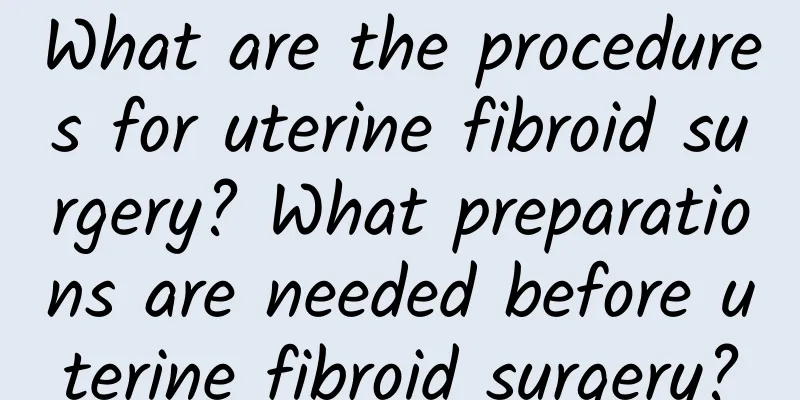What are the procedures for uterine fibroid surgery? What preparations are needed before uterine fibroid surgery?

|
Uterine fibroids are a common benign tumor in the field of female reproductive health. They can grow on the lining of the uterus and cause a variety of uncomfortable symptoms. For patients whose symptoms are severe and cannot be relieved by other treatments, uterine fibroid surgery is usually the best treatment option. So, what does uterine fibroid surgery involve? Let's take a look. Uterine fibroid surgery includes a variety of different surgical methods, and the specific surgical method will be determined according to the patient's specific situation and the characteristics of the tumor. The following are some common uterine fibroid surgery items: 1. Myomectomy: This is the most common surgical method and is performed through a hysteroscope or laparoscopy. During the operation, the doctor will remove the uterine fibroids and preserve the uterus. This surgical method is very effective for patients with small fibroids that are confined to the endometrium. 2. Myomectomy: For patients with larger fibroids or those located deeper into the uterine wall, a resection may be required. This surgery may require the removal of a portion of the uterine wall, which may affect the patient's fertility. 3. Uterine fibroid embolization: This is a non-surgical treatment for patients who are not suitable for surgery. In this process, the doctor will inject an embolic agent into the blood vessels supplying the fibroids through a catheter to reduce the size of the fibroids. No matter which surgical method you choose, patients will need to do some preparation before surgery. Here are some common preparation items: 1. Preoperative examination: Before the operation, the doctor will conduct a detailed physical examination, including gynecological examination, color Doppler ultrasound, etc., to assess the patient's uterine fibroids and physical condition. 2. Blood test: A series of blood tests are required before surgery, including blood routine, coagulation function, liver function, etc. These tests can assess the patient's blood condition and surgical risks. 3. Other auxiliary examinations: Imaging examinations such as pelvic ultrasound and MRI may be required before surgery to more comprehensively evaluate the size and location of the fibroids. 4. Psychological preparation: Before surgery, the patient needs to communicate fully with the doctor, understand the risks and prognosis of the surgery, and be mentally prepared. In short, uterine fibroid surgery is an effective means of treating fibroids. Through different surgical methods, doctors can choose the appropriate treatment plan according to the patient's characteristics and the condition of the fibroids. However, before the operation, the patient needs to do a series of preparations to ensure the smooth progress of the operation. |
Recommend
The most professional hospital for menopause
Many female friends often feel that their vulva i...
Is it normal for blood clots not to fall out during menstruation?
Is it normal for blood clots not to fall out duri...
What should you pay attention to after a miscarriage? The sooner you know, the sooner you will benefit
After a miscarriage, you must pay more attention ...
What is exercise intensity and exercise dosage? Rehabilitation Physician: 7 Essential Conditions for a Complete Exercise Prescription
As modern society becomes more and more convenien...
The annoying fat in the waist is hard to lose, shock wave lipolysis can help eliminate it
Loving beauty is a woman's nature, and losing...
Can I detect it after medical abortion?
Some patients feel that pregnancy is a difficult ...
Reasonable exercise can effectively prevent pelvic inflammatory disease
Pelvic inflammatory disease is a common gynecolog...
Did you know that uterine bleeding is a symptom of uterine fibroids?
Whether uterine fibroids have symptoms and their ...
Coffee not only refreshes you, but also helps you lose weight and improve fatty liver! 5 good articles to take notes on, drink coffee healthily
Coffee is the golden drink of choice for many peo...
The common manifestations of dysmenorrhea in daily life
Dysmenorrhea is very common in life. After suffer...
Diabetics should control carbohydrate intake. Weight loss diet showdown - Part 2
There is another large dietary study worth mentio...
The color of menstruation is very dark red, it feels a bit black, and the amount is small. What's wrong?
The menstrual period is very dark red, feels a bi...
What are the hazards of congenital absence of vagina to women?
Congenital absence of vagina is a rare disease in...
How to treat cervical warts professionally
There are many treatments for cervical warts. The...
What are the causes of pelvic peritonitis
What causes pelvic peritonitis? Why are women ver...









